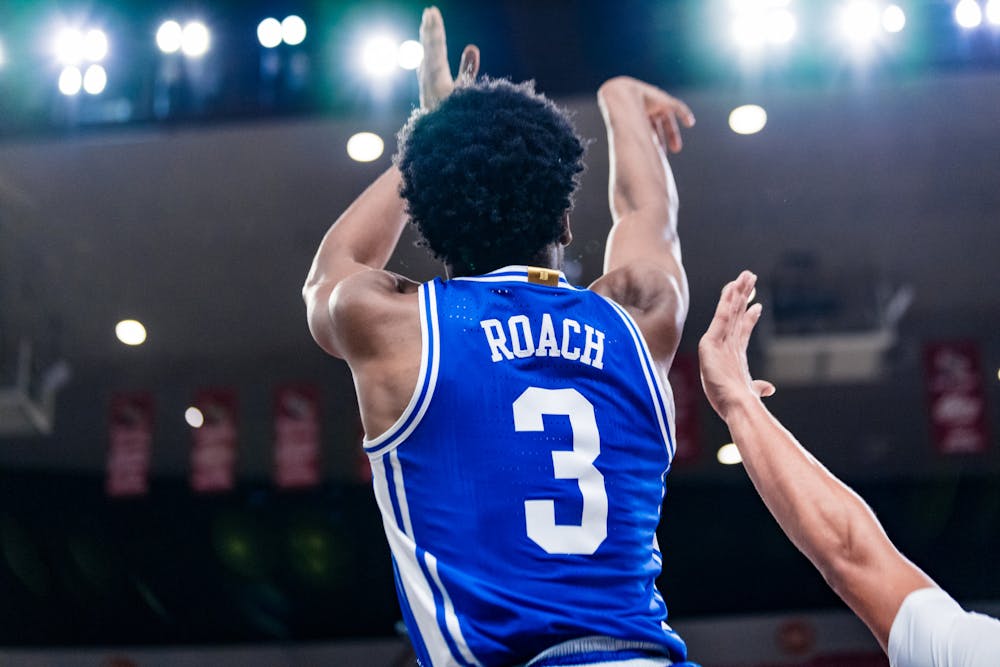It was expected that Duke would need some time to find its identity. With a new head coach at the helm, two star freshmen working to return after preseason injuries and a host of new faces, it takes more than just a few practices to mesh and find what works.
But so far, Duke has proved to have several keys for success up its sleeve. It can rely on star freshman center Kyle Filipowski to stretch the floor and execute on both ends when the going gets tough—which it did in its 54-51 victory over Oregon State Thursday afternoon, in which Filipowski scored a career-high 19 points and earned his fourth double-double of the season. The Blue Devils’ defense has also been a key attribute in several appearances, carrying them through their rout of Bellarmine and facilitating a late 13-5 run against the Beavers to finally regain the lead after 11 minutes.
After its narrow rout of the Beavers, though, the question remains—can Duke continue to find success without a clear team identity?
One of the most glaring areas in which Duke needs to find a rhythm is in its shooting. Right from the gate, it seemed unsteady offensively Thursday, perhaps flustered by Oregon State’s agile zone defense. Attempting four threes in the first four minutes, Duke struggled to adopt a clear offensive strategy. But as the half progressed and the Blue Devils eventually adjusted to finding opportunities inside the paint, they also simply had trouble finishing on available opportunities. Duke ended its battle in Portland, Ore. shooting just 5-for-29 from the 3-point line—a 17.2% mark—and 26.7% from the field.
“Their switching defenses really hurt us; I thought it stood us up,” head coach Jon Scheyer said after the game. “It made us really hesitant on offense, I thought that was pretty obvious.”
While Filiposwki and Young led with 19 and 11 points, respectively, many of their finishes came on recoveries from missed attempts; the former’s late-game layup after a missed jumper by graduate wing Jacob Grandison ended a seven-minute field-goal drought for Duke. One could claim that the Blue Devils’ offensive identity is built on their ability to earn second-chance points, which accounted for 33% of their points against the Beavers. But as teams become more physically competitive with the Blue Devils, they might not always find the same dominance on the boards that they have had early in the season.
Duke has also thrown around the idea of its identity being rooted in quickly turning defense into offense, which the Beavers’ defensive scheme made difficult early on Thursday.
“I think that's something that we've kind of made an identity for ourselves: starting on the defensive end and letting defense translate to our offense,” sophomore guard Jaylen Blakes said at a Nov. 14 media availability. “I think we're doing a great job this season of versatility and just keeping people out of our paint.”
It picked up later in the game as Filipowski and junior guard Jeremy Roach notched a couple of steals—Duke ended with 10 points off turnovers—but developing this identity will be a matter of more quickly adjusting to new defensive schemes that different teams bring each game.
Based on that, Duke can only progress toward quickly finding an identity if its young team adjusts to college-level play and begins to play settled. Only then will it really be able to take its time on the court to find what works best offensively, rather than taking quick threes or trying to draw fouls on layups. This process—of “sharing the ball, playing together,” as Scheyer said after Duke’s Monday win over Bellarmine—can be led by team captain Roach, who has been learning to find his voice as a new leader.
Roach, too, seemed to play unsettled as Duke struggled in the second half, committing two turnovers early in the half and missing four 3-point attempts. He did his job and led the team in vital moments, lifting Duke to a 47-45 lead late in the second half and even getting on the board first for the Blue Devils with a jumper. A consistent 40 minutes for Roach will help support a strong full-game performance from the younger players who look up to him.
A second-half surge against Delaware, combined with a standout performance from FIlipowski and Young in the closing minutes against the Beavers, suggests that maybe Duke’s identity thus far has been as a team that can step up when the going gets tough. But against high-caliber teams like Kansas, if Duke does not come out firing, close games will start tilting the way of opponents.
“As Coach Scheyer mentions, it’s tournament play,” Young said after the game. “And these games, you never have an easy game. Both teams are here, it’s a 12 p.m. game, people are ready to play and if you don’t come out firing, we had another slow start tonight, if we don’t come out demonstrative and aggressive, all of a sudden, it’s a dog fight.”
Get The Chronicle straight to your inbox
Signup for our weekly newsletter. Cancel at any time.

Leah Boyd is a Pratt senior and a social chair of The Chronicle's 118th volume. She was previously editor-in-chief for Volume 117.

